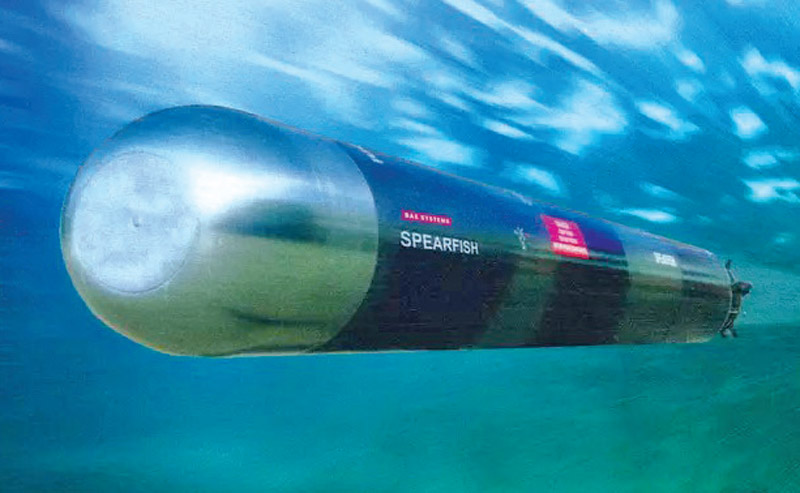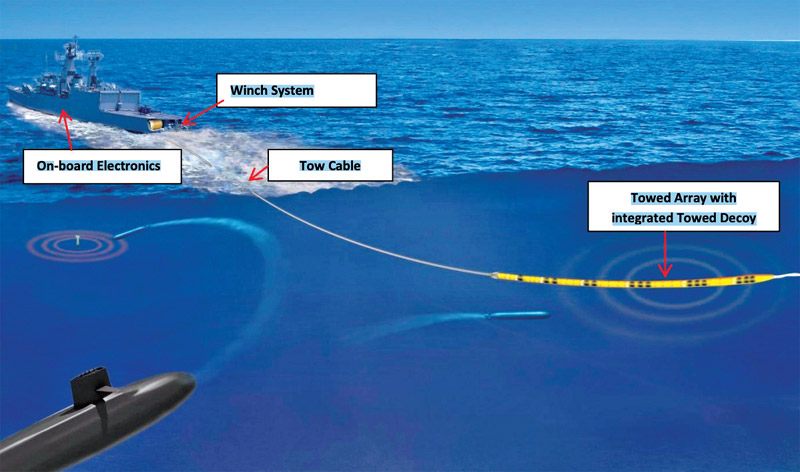Shortfall in Indian Navy’s underwater weapons is being alleviated by indigenously-developed systems
Atul Chandra
The Indian Navy is facing a shortfall of advanced torpedoes for its surface and sub-surface fleets. The threat of torpedoes in the modern naval battlespace poses complex challenges not only for submarines, but also for surface vessels. In what is emblematic of the continued travails in India’s defence procurement system, the navy’s newest Scorpene submarines are still without their complement of heavyweight torpedoes.
The Black Shark heavyweight torpedoes originally meant for the Scorpene fleet were to have been provided by WASS, a subsidiary of the Italian firm Leonardo. But this was scuttled because of allegations of illegality with another Leonardo subsidiary, the AgustaWestland. As things stand currently, the Ministry of Defence (MoD) is yet to conclude a contract for heavyweight torpedoes for the Scorpene fleet. The Navy’s German HDW Shishumar Class diesel-electric submarines carry Atlas Elektronik AEG Surface and Underwater Target (SUT) 264 21 inch heavyweight wire-guided torpedoes. However, the AEG SUT 264 first entered service in the 1967 and is unsuited for the modern naval battlespace.
The situation is slightly better on the airborne front, with the Indian Naval Aviation operating the Boeing P-8I maritime patrol aircraft, equipped with Raytheon MK 54 lightweight torpedoes for Anti-Submarine Warfare (ASW) missions. These ASW weapons will also be fitted on the navy’s Sikorsky MH-60R Romeo ASW helicopters. The MK54 lightweight torpedo has now been in production for two decades. The MK54 ASW weapon can be deployed from surface ships, helicopters and fixed wing aircraft to track, classify and attack underwater targets. The state-of-the-art torpedo utilises sophisticated processing algorithms to analyse the information and remove false targets or countermeasures. The MK54 was designed for operations in both deep water and littoral environments and is capable of striking any target regardless of water depth.
While the Defence Research and Development Organisation (DRDO) has been successful in developing indigenous underwater weapons such as the Varunastra, a ship launched heavyweight torpedo and Torpedo Advanced Lightweight (TAL), these cannot be launched from submarines. However, one can assume that based on the successes in developing the Varunastra and TAL, the DRDO will soon have a submarine launched torpedo available to meet the Navy’s urgent requirements.

New Entry
The navy is acquiring at least 73 Varunastra ship launched heavyweight torpedoes. According to the DRDO, the advanced state-of-the-art ship launched heavyweight ASW torpedo is capable of targeting submarines operating in shallow/deep waters. The nearly 8m long 533mm torpedo has an operating depth ranging from 8–600 m and can attain speeds of 27 and 40 knots. The combat version of Varunastra weighs 1,850 kg. Some of the attributes of the Varunastra ship launched heavyweight torpedo are: long range with multi manoeuvring capabilities, acoustic homing with wide look angle capable of tracking silent targets, ECCM features and multiple signal tracking system, autonomous advanced guidance algorithms and low drift navigational systems over long endurance. Deliveries to the Indian Navy commenced in November 2020 with Bharat Dynamics Limited (BDL) as the designated production agency.
The BDL has also delivered in excess of 25 TAL underwater weapons to the navy. The electrically propelled self-homing 324 mm TAL is 2,752 mm long and weighs 191 kg, including an explosive weight of 40 kg. The TAL can operate from depths of 10m to 450m and has a speed of 33 knots with an endurance of six minutes. It can be launched from warships, maritime helicopters and fixed-wing aircraft. The TAL was flight tested for the first time in 2021 when it was dropped from a Navy IL-38 SD maritime patrol aircraft. The BDL has also obtained export orders for the TAL with the Myanmar Navy in 2017.
The DRDO is also developing a supersonic missile assisted torpedo as a next generation missile-based standoff torpedo delivery system. The Supersonic Missile Assisted Release of Torpedo (SMART) system has been designed to enhance the navy’s anti-submarine warfare capability, beyond the conventional range of a torpedo. The missile is launched from a ground based mobile launcher. The canister-based missile system features a two-stage solid propulsion, electro-mechanical actuators and precision inertial navigation.

Torpedo Decoys
In June 2020, the Navy’s ASW capability received a major boost with the conclusion of a contract for the Maareech Advanced Torpedo Decoy System. It can be fitted on all frontline warships. The Maareech system is used to detect, classify and offer countermeasures against an impending torpedo attack and consists of mainly four subsystems, that is the Wet End system, Winch System, Onboard Electronics and System Software. The Wet End system consists of different modules of sonar arrays such as the main array for detection, L/R ambiguity resolution array, towed decoy module, fibre optic conversion module, tow cable and tail rope for inducing drag. The tow cable is attached to the Winch System which is used for deployment, retrieval and stowage of the Wet End. The Winch System has multiple modes of operation, various safety interlocks and remote operation capability.
Data is received by the Onboard Electronics via fibre optic telemetry from the towed array to the Winch, and by electrical telemetry from the Winch onwards. The Onboard Electronics comprise of specific hardware modules for signal processing and display, data recording and data sharing with the Tow Cable Towed Array with integrated Towed Decoy Winch System Onboard Electronics fire control system. The system also uses Hull Mounted Sonar sensor data for torpedo detection. The system software which resides on the onboard hardware modules implements advanced signal processing algorithms for torpedo detection, classification and decoying of torpedoes. The Maareech anti-torpedo decoy system has been designed and developed indigenously by DRDO labs–the Naval Science & Technological Laboratory (NSTL) and the Naval Physical & Oceanographic Laboratory (NPOL). The BDL is the designated production agency for the decoy system.
In May, this year, Rafael and DSIT unveiled a unique torpedo integrated defence suite for surface vessels. The two companies have developed a one-of-a-kind solution to address an urgent operational need for a comprehensive torpedo defence suite for surface ships. The integrated defence suite includes the highly effective Blackfish and Monkfish Torpedo Detection and Alert Sonar (TDAS) Hull Mounted Sonar (HMS) systems. The TDAS and HMS work continuously while the ships are at sea and are equipped with the latest technology to actively detect, classify, track, and alert on incoming torpedoes. The defensive suite also features Rafael’s Torbuster SP hard kill decoy, which can be strategically mounted on ships to deceive and neutralise incoming torpedoes, providing critical seconds for the ships to manoeuvre and evade attack. The Torbuster SP can defend against passive and active torpedoes, as well as wake-homing torpedoes. In the case of passive torpedoes, it simulates the ship’s acoustic signature to lure the torpedo away from the vessel, while for active torpedoes, it provides a near real-time tailored response based on the torpedo’s transmission. The hard kill decoy is designed to neutralise incoming torpedoes and prevent re-attacks.

New Torpedoes
Amongst the latest developments in advanced torpedoes worldwide is the British Spearfish Mod-1 upgraded heavyweight torpedo, which was declared ready for frontline action with the Royal Navy in May 2021. The improved Spearfish Mod-1 version is slated for entry into operational service with all Royal Navy submarines by 2025. The UK’s ministry of defence had taken the decision to upgrade the Spearfish torpedo in 2010. The Spearfish Mod-1 features a new warhead, safer fuel system and smarter electronics along with a high bandwidth fibre optic data link with its parent submarine, which improves its accuracy and lethality. The Spearfish weapon has been in the Royal Navy’s service for nearly 30 years.
Turkey’s Roketsan unveiled its Akya heavyweight torpedo in 2021. The Akya submarine launched weapon is a high speed, long range, fully autonomous/fibre optic wire guided torpedo with an active/passive sonar homing head. It also employs wake homing guidance for surface targets. Internal guidance is provided via internal and fibre-optic cabling. The Akya torpedo has a range of more than 50km and can attain a speed in excess of 45 knots. The propulsion system features a brushless DC electrical motor with a counter rotating propeller system. In 2022, Turkey announced the second successful launch of the Akya torpedo, this time from its Navy’s upgraded Preveze-class (HDW Type 209/1400) diesel-electric submarine.

